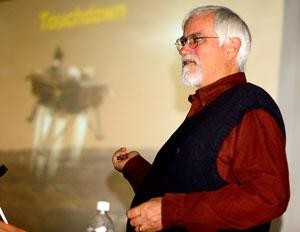In the Duval Auditorium of University Medical Center yesterday about 40 people from the Tucson community gathered to listen to Peter H. Smith, principal investigator for the UA’s Phoenix Mars Mission, explain the purpose and process of the mission to Mars.
“”Maybe we will be on the path to finding life on Mars,”” Smith said.
The lander will remain on Mars for 110 days and will use a robotic arm to take samples of the soil and test ice that has a reported temperature of negative 200 degrees Fahrenheit.
“”One-hundred and ten days seems like the snap of a finger because I have been working on this for six years,”” Smith said.
The mission will examine soil and ice samples searching for trace organics and evidence of how water has changed the subsurface environment. Minerals altered by water tells scientists if ice has melted.
The themes of the Mars mission are fire and water. Fire is a theme because there are eight ovens to cook soil samples and analyze the vapors emitted. This is to help understand minerals and ice content of the soil. Water also is a theme because the mission will be the first mission to touch and examine water on Mars.
Scientists of the Mars mission believe the planet used to be covered with water and are determined to find out where the water went.
It is also believed there is ice near the surface of the red planet.
“”The Phoenix mission is based on missions before it that have failed,”” Smith said. “”It is called the Phoenix because it is rising out of the ashes of the missions before it. The Phoenix is landing much farther north than the other landers.
“”Where you land is key to what you will discover,”” Smith added.
The 800-pound lander will travel 422 million miles and enter Mars at a speed of 6,000 miles per hour May 25. The UA is the first public university to ever launch a mission to Mars.









